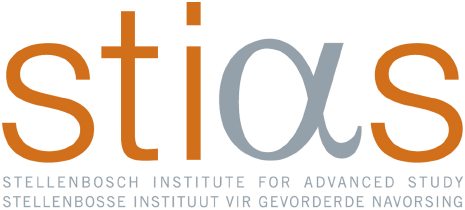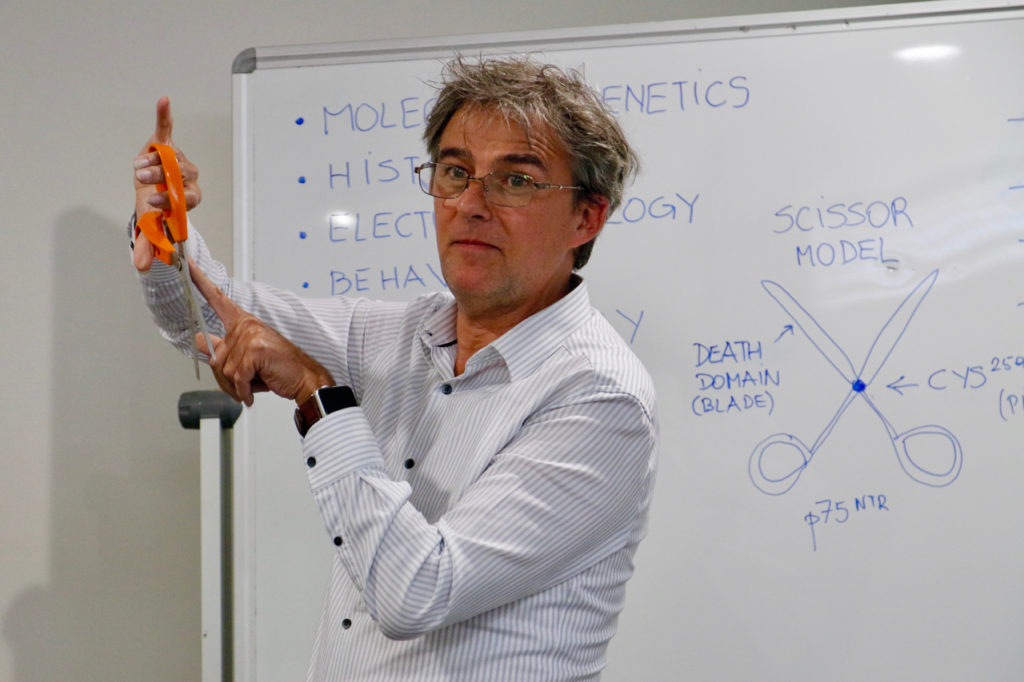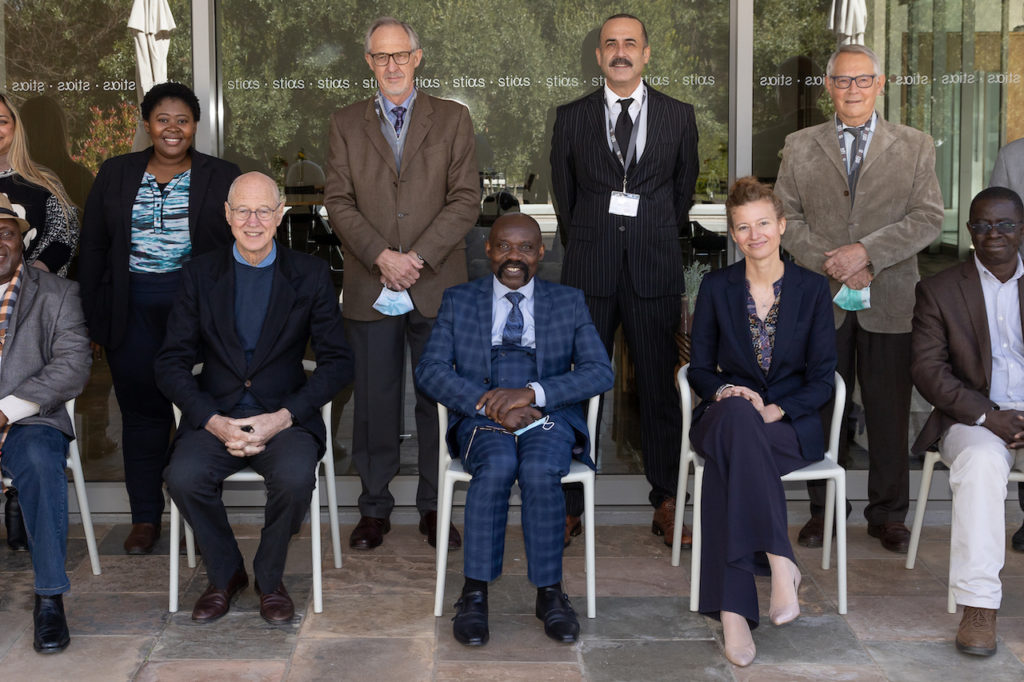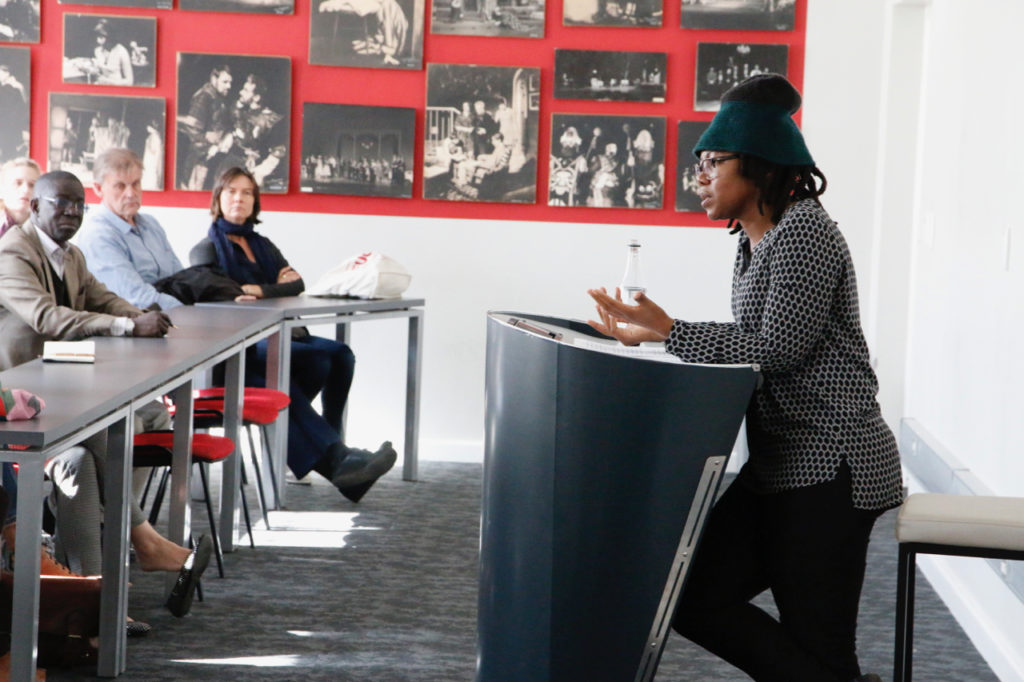The Stellenbosch Institute for Advanced Study aims to:
Advance scholarship across all disciplines and invest in the intellectual future of the country and continent;
2
Focus on Africa;
3
Provide an independent space where innovative ideas and original thinking can thrive.
STIAS is uniquely positioned to pursue these objectives because:
- It is the first institute of its kind in Africa and is modelled on successful international examples of institutes of advanced study. STIAS facilitates cutting-edge research for achieving breakthroughs in many fields, caters for all disciplines and encourages the cross-pollination of ideas.
- The setting enhances ‘out-of-the-box’ thinking and values diversity as a creative asset.
- It is uniquely placed within the fascinating research environment of South Africa – a crucible of diverse backgrounds, cultures, research traditions and life experiences.
- It focuses on real-life problems and sustainable solutions for the challenges of the country and the continent.
- It believes in the potential of Africa as a leading contributor to the global research community and producer of new knowledge.
Ethos: ‘A creative space for the mind’
The intention to nurture ’a creative space for the mind’ has, in an almost organic way, resulted in a very specific ethos which characterises STIAS and its work. It flows from an uncompromising commitment to quality, the encouragement of innovative thinking and stimulation of creative ideas.
This goal is pursued in the context of an institute for ’advanced study’, a term that describes both the level and the nature of its activities[1]. The focus is on the frontiers of science, exploring new possibilities and expanding the horizons of existing knowledge. STIAS caters for all disciplines, supporting work that is inherently interdisciplinary, but of a specific nature. The aim is not a collection of random ’studies’ (as the misnomer “institute for advanced studies” suggests) nor some generalised exchange of ideas, but rather to bring leading scholars together in a setting that encourages deep, fundamental and open interaction.
The ethos of STIAS is many-faceted and expresses itself in subtle and unobtrusive ways. Thinking is valued for its own worth, regardless of position or seniority. Fellows entering STIAS ’lose’ all titles and are addressed by name. Offices are of the same size and similarly equipped – a reminder of the equality implied by a ’republic of ideas’. This forms part of an ongoing attempt to ensure a ’democratic’ environment by undermining hierarchies and breaking down artificial barriers between disciplines and research traditions.
Although the Wallenberg Research Centre is in constant use, fellows are shielded from the daily hustle and bustle. The tranquil atmosphere of the garden and surroundings encourages concentrated, uninterrupted work. Researchers are disturbed as little as possible and contacts with colleagues and students from outside STIAS are initiated only at the fellow’s request.
The commitment to quality relates to both person and topic, following the dictum: “If you have the most interesting and promising project, but not the right people, don’t proceed”. The review processes remain the cornerstone of selection, informed by the core criteria relating to the potential of the project to generate new knowledge, the measure of interdisciplinarity, the proven record and scholarly reputation of the proposed fellow(s) and the relevance of the topic.
This evolving ethos comprises several, mutually supportive components.
The first is the culture of sharing. STIAS does not ‘claim’ any terrain or field of expertise as its exclusive domain. It does not ’own’ the results of its research projects, but shares these freely with the research community and public. It believes that the more ideas are shared and exchanged without constraints and conditions, the greater the benefit that accrues to science and society. This approach forms the basis for STIAS’s formal recognition as a Public Benefit Organisation.
STIAS sees its role as complementing not competing with existing research institutions. Given the challenges these institutions face today, STIAS offers an opportunity for intense, concentrated and uninterrupted attention to a specific topic, free from the duties of teaching and administration. It aims to add value to the global research community, offering an opportunity to retreat, regroup, reflect and, hopefully, prepare the ground for the next breakthrough.
Consequently, STIAS follows a modus of facilitating and enabling, rather than directing or regulating research. It works behind the scenes to provide the conditions necessary for creative thinking. It does not issue public statements or commit itself exclusively to one position, but aims to provide a ’neutral’ space where all viewpoints can be heard and debated.
In the same spirit, STIAS does not only promote its own research programme, but looks for ways to support the research priorities of other institutions. The experience gained from a number of roundtables where the latest research findings have been shared with decision- and policy-makers, has shown the need for such forums. The competitive nature of the university system increases the need for places where the common objectives and challenges of a discipline or research area can be investigated free from institutional interests or priorities.
Opting for the role of facilitator does not mean smoothing over differences or avoiding contestation. The intention is rather to ensure inclusivity and freedom. STIAS – as is true of all meaningful research – aims to foster a healthy and robust critical consciousness.
Being committed from the beginning to cater for all scientific disciplines, STIAS has developed a specific approach to interdisciplinarity. The traditional division between disciplines has, to a large extent, become dysfunctional, STIAS therefore encourages the crossing of borders and ’cross-pollination of minds’. However, it recognises that this can lead to superficiality and that the worst kind of interdisciplinary (or intra- or trans-disciplinary) research is done by ’failed disciplinarians’. It therefore sees no tension between specialists who continue to dig deeper in their speciality, provided they maintain an open mind and are able to relate their work to that of their colleagues. It also sees no contradiction in linking research on the highest level to research of the highest relevance, recognising that real-life problems are often the stimulus for innovative research but also that quick fixes will not suffice for the complex and intractable challenges we face today. We have to think harder and penetrate deeper to find sustainable solutions.
Experience indicates that the best approach is to select the real leaders in their respective fields, bring them together and leave them alone to discover and develop their own interconnections. This goal influenced the design of the Centre where fellows are obliged ’to cross the floor’ to reach their offices, or the seemingly insignificant detail of having only one coffee/tea station in the fellows’ section. From many fellow feedback reports it is clear that incidental meetings around the coffee machine often give birth to a new idea or different train of thought.
It’s also important to respect the differences between fellows with regard to their personalities, temperaments, need for seclusion and/or engagement, working habits, dietary preferences and the like. Fellows are therefore afforded the largest measure of freedom, having 24-hour access to the building with just two obligations: to attend lunch and to give a seminar on their work accessible to non-specialists.
STIAS has a special focus on Africa and a long-term commitment to nurture coming generations of scholars and intellectual leaders on the continent. It is proudly African, but not in any exclusivist sense. Ideas are universal and science knows no borders. Part of the ethos is to foster ongoing dialogue between Africa’s brightest minds and their global counterparts. Africa cannot isolate itself from the world and has much to offer in terms of experience, insight and perspective.
[1] “An Institute for Advanced Study should engage at a higher level. A place, a time and an opportunity for fundamental research: these were the core factors.” (Wesseling, H 2002. The Idea of an Institute for Advanced Study. NIAS: Wassenaar, p. 5).
The implementation of the ethos: Between Planning and Serendipity
The founding director of STIAS, Bernard Lategan (1999-2007), shares his reflections on the ethos of STIAS twenty years after its establishment:
Although the content of any ethos is important, its proof lies in its implementation. The following is an attempt to document insights and experiences which may be useful for the future evolution of STIAS. It is a tale of trial and error and, in essence, a cumulative undertaking – many people were involved in the establishment and development of STIAS. Additions and corrections from their experiences and perspectives are therefore valuable.[2] However idealistic the vision of an institute for advanced study may be, it is naïve to conceive of it as a free-floating entity in esoteric isolation. The hard reality is that it must eke out a foothold in a highly contested environment. More particularly, the terrain on which research and science operate is marked by a constant tension between the inherent nature of science and scientific discovery and the external demands made on it by society.[3] Rather than trying to escape this tension, the challenge is to respond to it with imagination and sagacity. The former Secretary of the Wissenschaftskolleg zu Berlin, Joachim Nettelbeck[4] stresses the importance for higher education to create Freiräume for science where the independence of research and the freedom of inquiry can be protected and nurtured. In the case of STIAS, this insight is expressed by the motto: ’A creative space for the mind’.
The essential ingredients to make this intention a reality are a compelling idea, a group of committed people and a suitable (physical) place.[5] In the case of STIAS these elements were combined with a measure of good fortune and some unexpected windfalls.[6]
The overarching idea serves several purposes. It acts as compass to orient the implementation process. It should therefore be generic enough to transcend the founding period to provide direction during successive development phases, but also be flexible enough to adapt to changing circumstances.
It also facilitates the transition between successive cohorts of management. If the institution is too closely associated with one person or group, its chances for longevity are slim. The idea must be strong and compelling enough to carry it beyond an individual or generation.
Furthermore, the idea fosters cohesion in leadership and in STIAS as a whole. It is the common ground which binds individuals from diverse backgrounds, disciplinary perspectives and personalities together – and, in the process, builds trust. Commitment to the idea helps to deflate egos and encourages a facilitating rather than domineering attitude. In other words, it engenders generosity – a generosity flowing from the realisation of incompleteness. Incompleteness of the individual and his or her knowledge and imagination, the incompleteness of a single discipline and the incompleteness of the human condition.
[2] This compilation was prompted by Joachim Nettelbeck’s personal reminiscences of the Wissenschaftskolleg and similar institutions – cf. Nettelbeck, J. 2019. Verwaltung von Wissenschaft, eine Kunst. Berlin: Max Planck Gesellschaft. Although the history and context of the two institutions are different, there are striking similarities between Wiko and STIAS, reminding us of generic values and principles important for the successful establishment and operating of institutes for advanced study. A comparative discussion cannot be pursued here in any detail.
[3] Nettelbeck (2019: 34) talks of the “innere Urgesetzlichkeit wissensachaftlichen Arbreitens”. A recent example of this tension in the South African context is the pressure on universities to take on roles and to provide services which are in reality the responsibility of the state, thereby usurping energy and resources which should be devoted to its core function of innovation and teaching. – Nico Cloete, University News.
[4] 2019: ii. WHat is required therefore is “reflexive Verwaltung” aimed at “Freiheitsbekündiging” as the source of vitality for such institutes.
[5] “Eine Idee, eine Person, die sich ihr verschreibt, und ein dafür geeignetes Haus” (Nettelbeck 2019: 33).
[6] What Nettelbeck calls “serendipity” and which characterizes both the scientific process and the history of these institutions (2019: vii; 9-13).
The selection process
The first and foremost consideration which guides all activities of STIAS is that of quality – the quality of its fellows and of its research programme. Everything else depends on this – STIAS’s reputation, its ability to attract top scholars from across the globe, and the significance of its contribution to science and to the public good.
In its unrelenting quest for quality, the selection of fellows and research projects lies at the heart of STIAS’s activities. This process is guided by the demand for transparency and accountability. Every individual involved with STIAS – in whatever capacity or function – shares the generic responsibility to be constantly on the look-out for new ideas, new challenges, new developments in science and society and, of course, for the best scholars in their respective fields to attract as fellows. This permanent scouting mission is the lifeblood. It is an open and non-hierarchal process – names and ideas, whether they come from top or bottom, from the Board, Committees or individuals, whether from insiders or outsiders, whether from academia or wider society – all avenues should be available.
The actual selection process follows a more structured course, moving through various circles. At the centre is the Fellowship and Research Programme Committee, chaired by the Director. All proposals, names and suggestions – regardless of origin – are channelled to this Committee who considers them in a first round – either at its regular meetings or bi-annually in expanded format to select core cohorts for a specific semester. Each proposal is individually evaluated in view of established criteria. Where applicable, further expert opinion, independent review or additional information is obtained from the most suitable source, be it experts in a specific field, academics from other institutions, referees or former fellows. A second circle is formed by the Academic Advisory Board who has access to all information relating to the academic programme, reviews outcomes on an annual basis and gives advice about future opportunities or directions to explore. The Board of Directors represents the third circle and the highest level of governance of STIAS as Public Benefit Organisation. It is responsible for all aspects of the Institute, its performance, finances, management and staff. The Director is appointed by the Board reports to the Chair of the Board, and is answerable to the Board.
Selection of fellows and projects rely on the dual pillars of advice and decision-making. Selection relies heavily on the honoured custom of collegial co-operation, reasoned criticism and peer review. All involved in selection are therefore obliged to seek out the best possible expert opinion and independent evaluation and to practice vigorous but unbiased scrutiny. The Director especially, however expert he or she may be in a specific field or fields, is obliged to consult, as an inherent part of his or her responsibility. The Programme Committee (whose members are chosen because of their specific expertise) likewise recognises the limits of their own reach and therefore welcomes and relies on the expertise of others wherever necessary. For the same reason, a regular rotation of Committee members is essential, preserving a healthy balance between ensuring renewal while retaining continuity and institutional memory.
Accountability requires that reasons are recorded for the decisions taken.
It is further important to underline that whatever the advice, expert opinion, independent reviews, discussions and conclusions reached in the course of the various stages of considering fellows and projects, the power of decision finally lies with the Director. In other words, selection is not based on committee decisions or majority vote, but on personal responsibility. This procedure protects individual committee members in situations where decisions are made which affect their colleagues and peers but also enables them to participate in deliberations without fear or favour and to express their views without fear of incrimination.[7]
As already indicated, the responsibility to decide also makes it obligatory for the Director not only to consult, but to do so in good faith and to be able to provide reasons for decisions. Should a Director ignore this obligation or reject sound advice and consistently make bad decisions, the Board (who as appointed him or her) has the option to end the relationship.
[7] This position is not unique or unusual. Nettelbeck makes a strong plea for such a procedure based on the division of responsibilities and argues the case extensively in view of his experience at the Wissenschaftskolleg (Nettelbeck 2019: 44-45):
“Ein Rektor, der so ermächtigt wird, über Berufungen über alle Disziplinen und Kulturen hinweg zu entscheiden, ist aufgrund seiner eigenen Kenntnisse, wie gebildet er auch sein mag, nicht wirklich sachkundig. Er ist auf den Rat der Permanent Fellows, des Beirats und der Gutachter angewiesen. Er sollte sich gezwungen fühlen, sich mit anderen Sichtweisen auseinanderzusetzen. Da- für ist das institutionelle Arrangement mit dem Beirat besonders wichtig. Der Beirat stellt eine Art wissenschaftliches Gewissen der Institution dar. Formal hat er den Rektor zu beraten. Dessen Zuständigkeit, letztlich zu entscheiden, bleibt unangefochten. Diese Klarheit der Verteilung der Rollen gibt dem Rat ein unvermutetes Gewicht. Sie entlastet das einzelne Beiratsmitglied von der Verantwortung und ermutigt so zu einem offenen – manchmal auch kontrover- sen – Urteil, dessen Gewicht auf seinen Begründungen beruht, im Unterschied zu einem Gutachter, dessen herausgehobene Stellung im Fach seine besondere Maßgeblichkeit unterstreicht. Das einzelne Beiratsmitglied hat die Gründe sei- ner Stellungnahme nicht nur dem Rektor mitzuteilen, sondern auch im Kreis der anderen Beiratsmitglieder zu vertreten. In dieser Situation, mit gleich gestellten Kollegen anderer Disziplinen und anderer Länder, ohne gegenseitige Verbind- lichkeiten, kommt alles auf das überzeugende Argument an, nicht auf die Stel- lung. Gerade weil unangefochten ist, dass der Rektor letztlich zu entscheiden hat, gewinnt der Rat effektiv die Funktion, die Entscheidung des Rektors auf eine breitere Basis zu stellen. Die Situation nähert sich dem Habermas‘scher Ideal der rationalen Verständigung und zwingt auch den allmächtigen Rektor, dem Beirat gegenüber gute Gründe für seine Entscheidungen zu haben, wenn er von seinem Rat abweichen will.”


Our logo
The inauguration of the Wallenberg Research Centre in 2007 signalled the beginning of a new phase in STIAS’s existence and presented an ideal opportunity to revisit the STIAS logo. The original logo emphasised the ‘i’ in the centre of the word, placing the focus on ‘institute’, which is not the core concept. The logo was also often used with a line drawing of the Mostertsdrift manor house, emphasising the past rather than the future.
The brief given to the designer John Pace was to rethink the existing logo, to make it contemporary, clean, simple, future-oriented, Africa being central and not added on, with reference to the new Research Centre as an expression of ‘a creative space for the mind’.
The result is a shift from the ‘i’ to the ‘a’, which achieves several levels of integration and association:
- The ‘a’ stands for both ‘Advanced’ and ‘Africa’, integrating the two core elements of STIAS’s mission: To promote research on the highest level on issues of the highest relevance to the region and the continent. It is also an expression of belief in the intellectual and creative potential of Africa to take its rightful place in the global search for new knowledge. It refers to the intention of STIAS to provide a ‘creative space for the mind’ and to do so specifically in Africa as one of the most interesting research contexts of our time.
- The ‘a’ also symbolises the creative interaction between different research disciplines and research traditions, especially between the humanities and the natural sciences. The Greek alpha has rich associations with different aspects of the humanities and social sciences – from ars poetica, (linguistics and literature) to agape (theology) to agora (philosophy, politics and the foundations of democracy). Greek symbols often appear in mathematics, the ‘grammar’ of the sciences, and are widely used in all branches of the natural and applied sciences. In statistics, the alpha value quantifies the degree to which something is significant (not simply due to chance).
- The ‘a’ refers both to the creative power of diversity and to the importance of a critical consciousness: the diversity of ideas, of research traditions, of disciplines, of cultural contexts, of perspectives, requiring critical discernment and assessment.
- Alpha also signals the first (in Africa), the seminal beginning of thought and new ideas, of quality and of excellence.
The logo forms an entity on its own, but in combination with the core statement ‘a creative space for the mind’ and the line drawing of the Wallenberg Research Centre, these concepts are reinforced.



